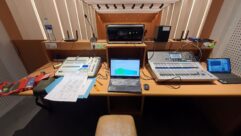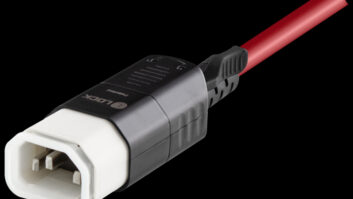Check It Out!
Dec 1, 1998 12:00 PM,
Sam Berkow and Alexander Yuill-Thornton II
A common request made of sound system contractors and acousticalconsultants involves the evaluation of an installed sound system. Thisrequest, often heard in a first phone call, may include such concerns as alack of speech intelligibility or uneven coverage. Just as likely areevaluative, vague comments involving insufficient punch in the system, thesound’s not being right or an uncertainty as to whether the existing systemis operating at its maximum potential. Regardless of the initial customercomment, however, there are a number of questions that must be asked andanswered-some technical, some financial. Chief among them involvesdetermining the best method of establishing the problem’s nature.
Assume that you have been asked to evaluate the sound system in a facilitywith an actual problem. The facility could be anything from a church orconvention center to a studio, club or even a stadium or arena. Whateverthe facility or system, one of the most perplexing technical considerationsis also one of the most frequently neglected, and it requires determininghow much of the problem is attributable to the sound system design(components and configuration) and how much results from the facility’sacoustical environment.
The performance of an installed sound system can be evaluated in a numberof ways; coverage, frequency response, power handling and configuration areall important areas to explore. Where to begin? Critical listening iscertainly a primary component of any system evaluation, and it should bethe goal of any measurement tool to provide data that helps a userunderstand what he or she is hearing.
In any event, you arrange a site visit in response to the facility’stelephone calls. Hopefully a paid visit, it may turn out to be a courtesycall. The politics and economics of this first call fall under the domainof another article. You may wonder what can actually be accomplished in asite visit or which tests are effective. I suggest that the following stepsbe used as a guideline, and as such, they are not intended to be followedin exact order for every case. They present an outline that can be adaptedto almost any situation.
User requirements and expectationsThis first step can begin during the initial telephone call. Find outexactly what the user expects of the system. Next, evaluate whether or notthe current requirements are even remotely similar to the performancerequirements established during the system’s original design. These areboth critical steps in explaining the need for changes to a system. A clearexample would be a church sound system that had been originally optimizedexclusively for speech use and was currently used for modern musicreinforcement.
Systems configurationThe next step typically begins with a review of every available systemblock diagram. If such documentation exists, it can be extremely useful(and maybe profitable) for the consultant/contractor to offer to help thefacility develop even simple one-line drawings. A lack of documentation foran existing system may also be an indication that the facility isneglecting proper system upkeep and maintenance. If possible, review thesystem configuration prior to arriving at the site. Once on site, verifythat the system is actually built as drawn. It is not uncommon to find thata system’s documentation and the actual installed system represent two verydifferent realities.
Critical listeningStep three has several parts. To begin, I suggest listening to the roomwith the sound system off. It is often a good idea to have the HVAC systemturned on and off to identify its contribution to the facility’s ambientnoise. The role of ambient noise in reducing speech intelligibility isoften overlooked, and in facilities where speech intelligibility orcritical listening is important, HVAC noise can have a considerablynegative impact.
Next, spend a moment listening with the sound system powered on and thesystems gain turned up to typical operating levels but without input. Asystem with hiss, hum, buzz or noise indicates problems with gain structureor possibly faulty components. Once these symptoms have been identified,steps can be taken toward isolating their causes, which, in turn, may leadto identifying or even resolving the facility’s original problems.
Critical listening of the actual sound system performance should begin withplayback of material familiar to the listener. Music with clearly definedparts (snare drums, kick drums and vocals) is particularly useful becausethe perceived relative levels of each part can be easily compared by ear.
Walk the room while activating each part of the system individually and ingroups. A common concern is listener areas in overlap zones, areas wherethe listener receives sound from two or more loudspeakers. In these cases,you must determine the relative role of each sound source and itscontribution to what a listener in the overlap area hears.
Critical listening should also be done at levels typical for systemoperation and at levels low enough to allow evaluation of coverage withoutfatiguing the ears or excessively exciting the room’s acoustics. Whenexcited, highly reverberant spaces have a tendency to mask coverageproblems. Careful listening can identify areas where the relative amountsof direct and reverberant energy reaching the listener may be a concern.
At this point, listening to a live talker would also prove helpful. Keep inmind, however, that several variables (such as the mic in use and thequality of the talker’s voice) can introduce considerable variation intothis type of test.
Keep notes during the critical-listening process to aid in theidentification of potentially interesting areas for measurements,especially those areas with listener positions that seem to have problemsof one sort or another. Such problems are typically characterized by adramatic change in level or tonal response when compared to adjacent areas.Once such a location has been identified, establish whether the problem isdue to the sound system, the room or the means by which they both interact.An example of this distinction would be a location in which the loudspeakersounds distorted, possibly due to a faulty component, and another positionwhere a reflection from a balcony front (or other surface) causescancellations in a given frequency range.
Measurement and quantitative evaluationStep four is where measurement tools begin to play a role. Three types ofmeasurements are commonly used in the evaluation of an installedsystem-frequency response, impulse response and ambient and/or system noiselevels. Each offers valuable insight into the system’s perceivedperformance.
The frequency response of a system has traditionally been measured using areal-time analyzer (RTA). Because an RTA normally reads only the signaloriginating from the system for determination of frequency response, asignal whose frequency content is known is best for a source or stimulussignal. The most commonly used source signal is pink noise. Having equalenergy in each octave band by definition, pink noise looks flat onfractional octave band analyzers. Typically 1/1-, 1/3- or 1/6-octaveresolution is used.
Although an RTA is useful in many ways, particularly for ear training, theRTA’s value for understanding a room or optimizing a sound system islimited. A major deficiency in simple RTAs reduces its effectiveness inevaluating sound system performance and renders it completely unable tomake distinctions among problems arising from the sound system, acousticalproblems in the room and interactions between the two. These limitationsare attributable to RTA’s time blindness. In other words, RTAs can registeronly the result of the sound system’s performance and its interaction withthe room’s reverberant energy. It cannot separate these factors. To addressthis situation and provide more insight into the room’s or system’sfrequency response, transfer function-based measurements are necessary.
Transfer functionThe transfer function of a system is a comparison of the system’s input andoutput, which can be calculated in either the time or frequency domain.Transfer functions are usually measured with a two-channel measurementsystem in which the input signal and output of the system are sent to themeasurement device. The comparison of these two signals will include somesort of time windowing, which allows the system to read the response of thesound system itself and limit the amount of room response included in themeasured data.
This ability to exclude or at least reduce the room’s contribution to thefrequency response measurement is especially useful when settingcrossovers, delays and EQs. It is important to note that these devicesaffect only the signal going through the sound system and not the responseof the room itself. This distinction provides some insight into the topicof system optimization where the goal is enhancing a sound system for thebest possible response given its interaction with itself and the acousticalenvironment.
To improve this ability further, some modern transfer-function measurementdevices provide a frequency-dependent time-windowing feature. The use ofseveral time windows (typically longer windows at low frequencies andincreasingly shorter windows at higher frequencies) correlates well withthe nature of human hearing and provides useful frequency responseinformation for the evaluation of system performance.
To use the transfer function measurement for evaluation, begin bypositioning an on-axis measurement mic in a loudspeaker’s direct field(normally in the main cluster). Send the same test signal to the soundsystem and the measurement system. The output of the sound system, aspicked up by the measurement mic, is sent to the measurement system on aseparate channel. This dual-channel approach allows a precise comparison ofthe input signal (also called the reference signal) and the system’s output.
Before making the transfer-function frequency-response measurement,ascertain the total delay through the entire system with considerableprecision, including any throughput delay or latency in the sound systemitself along with the propagation delay from the loudspeaker through theair to the measurement mic. The reference signal must be delayed by anequal length of time at the measurement system to make an apples-to-applescomparison of the two signals.
Fortunately, this delay can also be measured easily by many modernmeasurement systems. One technique used to find the delay through a systemis to measure the system’s impulse response. An advantage to this techniqueis that it can give some other important pieces of information about theroom and the system, including polarity, direct-to-reverberant levels, thepresence of reflections and the reverberation time.
Once the delay has been found and compensated for, the frequency responseof the system may be measured accurately with the transfer function.Frequency response is usually represented as a graph with frequency on thehorizontal axis and magnitude on the vertical axis. The vertical axis isnormally centered on 0 dB, where 0 dB represents equal relative energybetween the input signal and output signal. Values above 0 dB representgain or resonance, and values below 0 dB represent either cancellation orattenuation.
Using the multiple time-windowing techniques mentioned earlier, the resultsof a transfer-function measurement can be displayed with equal resolutionacross the audible spectrum. This constant-resolution display is a majorimprovement in modern measurement techniques because it presents data in away that is easier to read and understand than traditional displays wherelow-frequency resolution was typically much lower than higher-frequencyresolution for a given measurement.
When measuring clusters, it is often necessary to examine each element ofeach loudspeaker system individually, a practice with several purposes.First, it verifies that each component is, in fact, working. Second, thetransfer function of each component will reveal whether the crossovers andamps are providing proper frequency and gain control. In areas covered bymore than one loudspeaker or cluster, inspecting the frequency response ofeach cluster or loudspeaker individually and in combination will offeradditional insight into the system’s performance.
Another advantage of transfer-function-based measurement systems is theirability to provide phase information about the system. The phase displayshows the relative delay in the output signal for each frequency. Thisinformation is essential for correctly setting precision delays withinindividual loudspeaker systems and between various systems making up acluster.
Although the time-windowing inherent in transfer-function measurementshelps isolate the system factors from room factors, frequency-responsemeasurement will still include some of the system’s interaction with theacoustical environment. This is one reason why most (if not all)transfer-function-based systems include some kind of coherence function,which can be used to judge the quality of the transfer function data,indicating noise contamination or other nonlinear events.
The impulse responseAs mentioned earlier, the delay through the system under test must be knownwith considerable accuracy before a valid transfer-function measurement canbe assessed. Although there are several useful techniques for measuringthis delay, a given system’s impulse response provides a great deal ofimportant additional information.
An impulse response is simply the response of a linear system to animpulse. A linear system is one whose output is not dependent upon theinput signal, such as a loudspeaker or room. An example of a nonlinearsystem would be a compressor; the level of the output signal is a typicallynonlinear function of the input-signal level. Measuring the impulseresponse of a system is actually a little more difficult than it may sound,which is primarily due to the practical difficulties involved in generatinga perfect impulse. There are, however, several systems available that usevarious mathematical techniques to calculate the impulse response of asystem and make it a fairly simple matter for users to perform thesemeasurements.
The information afforded by measuring impulse response is essential. Asidefrom the delay through the system, the polarity of the system is also partof the impulse response when plotted in the time domain with alinear-amplitude scale. When measuring a sound system in a room, includingthe direct-to-reverberant level and the presence and arrival times ofdiscrete reflections, the rate of broadband decay and the overall S/N ratioof the system can also be determined. Recently, a number of papers havebeen published showing speech-intelligibility calculations based uponimpulse response measurements. The direct-to-reverberant level is certainlyan important factor when evaluating a sound system’s speech intelligibility.
Although the impulse response may be displayed in the time domain, it isalso common to transform the impulse response of a system into thefrequency domain. This transformation uses a series of FFT (fast Fouriertransform) calculations and allows exploration of the system’s response asa function of frequency vs. time. Such displays as the 3-D colorspectrograph or more traditional waterfall plot can be used to displaytime, frequency, and energy characteristics of the system simultaneouslyand meaningfully. When looking at the impulse response of a sound system ina room, its response is often represented only in the earliest part of themeasurement. The response of the acoustical environment-reflections anddiffuse reverberant decay-tend to dominate the remainder of the impulseresponse measurement.
Ambient noise measurementsAdditionally, taking the time to measure the ambient noise level of a roomcan provide insight into HVAC noise problems and other noise sources thathave an adverse effect on speech intelligibility. Traditional octave-bandmeasurements, reported as NC or PNC values (noise criteria or preferrednoise criteria), are helpful in their own right, but modern FFT-basedanalyzers allow high-resolution measurements that can display the spectralcomponents of the ambient noise sources more completely.
When evaluating a sound system, looking at the spectral content of thesystem’s self-noise can offer insight into problems with gain structure andeven mains power connections and ground loops. Using high-resolution FFTmeasurements allows the impact of changes to the system to be easilyevaluated as problems are sorted through.
In conclusion, the ability of modern measurement systems to providetransfer function-based frequency response measurements, impulse-responsemeasurements and high-resolution noise-spectrum measurements provides apowerful set of tools for evaluating both the performance of a sound systemand the system’s interaction with its acoustical environment. Theavailability of fast and reliable PCs means that these measurementtechniques that were beyond the practical reach of most contractors andconsultants only a few years ago are fast becoming part of our standardfield evaluation toolkit.










